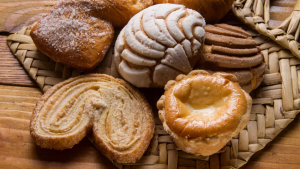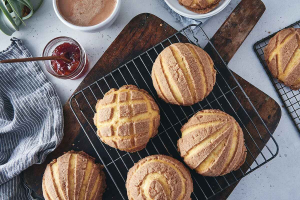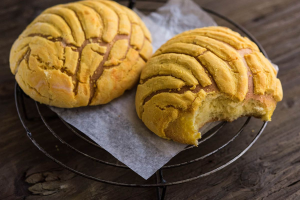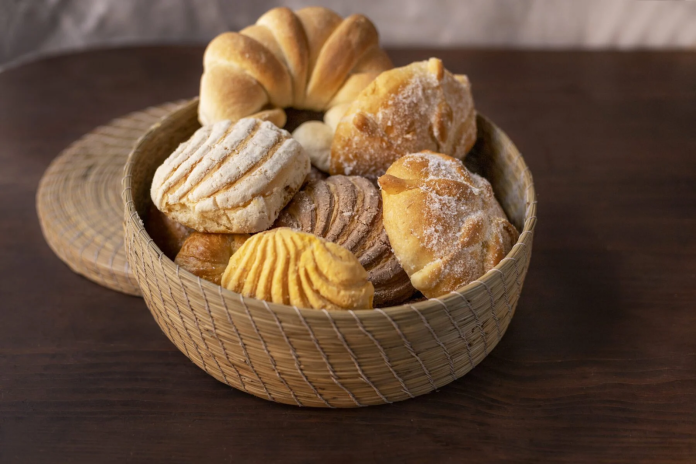Mexican Bread
When it comes to culinary delights, Mexican cuisine holds a special place in the hearts and palates of food enthusiasts around the globe. Among the many treasures that Mexico offers, its rich and diverse bread culture stands out prominently. From the enticing aroma of freshly baked conchas to the delicate sweetness of orejas, Mexican bread, also known as “pan dulce,” brings a symphony of flavors to the table. In this article, we delve into the captivating realm of bread, exploring its history, variety, and the cultural significance it carries.
Also read about Swiss Rolls
A Bite of History Origins of Mexican Bread
Ancient Influences on Bread Mexico’s bread heritage traces its roots back to the time of the Aztecs and Mayans, who had their own versions of flatbreads made from maize. These early forms of bread laid the foundation for the diverse array of bread we enjoy today.
Spanish Colonial Influence The arrival of Spanish conquistadors in the 16th century brought wheat to Mexico, giving rise to a fusion of European and indigenous baking traditions. This marked the birth of iconic bread varieties that combined Old World techniques with New World ingredients.
Ingredients:
For the Dough:
- 4 cups all-purpose flour
- 1/2 cup granulated sugar
- 1 teaspoon salt
- 2 1/4 teaspoons active dry yeast
- 1/2 cup warm milk (110°F/43°C)
- 1/2 cup warm water (110°F/43°C)
- 1/4 cup unsalted butter, softened
- 2 large eggs
- 1 teaspoon vanilla extract
For the Topping:
- 1/2 cup unsalted butter, softened
- 1/2 cup granulated sugar
- 1/2 cup all-purpose flour
- 1 teaspoon vanilla extract
- Food coloring (optional)
- Pearl sugar or colored sprinkles, for decoration
The Artistry of Bread: Types and Flavors
Panaderías:
Hubs of Culinary Creativity bread is an art form, and its creation is masterfully carried out in traditional panaderías (bakeries) across the country. These establishments are brimming with an astounding assortment of bread, each with its unique taste and story.
Conchas:
Sweet and Iconic Among the treasures of bread, conchas reign supreme. These round, sweet buns and Costco cupcakes are adorned with intricately patterned sugar toppings that resemble seashells, hence the name concha. The pairing of soft dough and sugary delight is a true testament to the mastery of Mexican bakers.
Orejas:
Layers of Delight Orejas, also known as “palmiers” or “elephant ears,” are delicate pastries that are both flaky and sweet. Layers of buttery dough are meticulously folded and baked to golden perfection, resulting in a treat that practically melts in your mouth.
Tres Leches Bread:
A Decadent Twist Building upon the popularity of the classic tres leches cake, bakers have transformed this indulgence into a delectable bread variety. Moist, rich, and soaked in a trio of milk, tres leches bread offers a unique take on a beloved dessert.

Exploring the Flavors: Regional Varieties of Mexican Bread
Regional Bread Diversity Just as Mexico’s landscapes vary from lush jungles to arid deserts, its bread offerings are equally diverse. Different regions of Mexico boast their own unique bread specialties, often influenced by local ingredients and culinary traditions.
Bolillo:
The Versatile Classic The bolillo, a crusty white roll with a soft interior, is a staple across Mexico. It’s the bread of choice for crafting tortas – delicious Mexican sandwiches filled with an array of flavorful ingredients.
Marranitos:
A Sweet Piggy Treat Marranitos, or “little pigs,” are adorable gingerbread-like cookies shaped like pigs. These treats are not only delightful to look at but also carry a lovely hint of molasses and cinnamon.
Rosca de Reyes:
A Kingly Delight Celebrated during the Epiphany, Rosca de Reyes is a circular sweet bread adorned with colorful candied fruits, representing the jewels in the crown of the Three Wise Men. It’s a beloved treat shared among family and friends.
Preserving Tradition: The Future of Mexican Bread
Nurturing Heritage Through Education As the culinary landscape evolves, there’s a growing effort to preserve the art of bread making. Workshops, classes, and culinary schools are helping pass on intricate techniques and time-honored recipes to the next generation.
Sustainable Practices in Baking In an era of heightened environmental consciousness, some bakeries are adopting sustainable practices, such as using locally sourced ingredients and reducing food waste. These initiatives ensure that the legacy of Mexican bread remains intertwined with a commitment to the planet.

Cultural Significance and Celebratory Traditions
Day of the Dead Offerings In Mexican culture, bread plays a central role during the annual Dia de los Muertos (Day of the Dead) festivities. Elaborately decorated pan de muerto, or “bread of the dead,” is offered on altars to honor and remember departed loved ones.
Sweetening Celebrations: Las Posadas During the Christmas season, a cherished tradition known as Las Posadas involves the sharing of sweet bread and warm beverages among friends and family. This heartwarming ritual symbolizes unity, hospitality, and the spirit of giving.
The Culinary Artistry Behind Mexcan Bread
Craftsmanship and Tradition Creating authentic Mexican bread requires a deep understanding of the craft. Bakers meticulously follow time-honored recipes and techniques passed down through generations, ensuring that each batch maintains the bread’s distinctive flavors and textures.
A Labor of Love: Hand-Shaped Conchas The process of making conchas involves not only baking but also intricate hand-shaping of the dough and delicate application of the iconic sugary topping. This meticulous attention to detail highlights the true dedication of Mexican bakers.
Modern Twists on Tradition: Fusion Baking
Fusing Cultures:
Mexi-French Pastries Modern Mexican bakeries are experimenting with innovative fusions, combining Mexican flavors with French pastry techniques. The result? A tantalizing array of Mexi-French pastries that offer a unique and exciting gastronomic experience.
Chocolate Abuelita Croissants:
A Chocolaty Surprise Imagine biting into a flaky croissant filled with rich, velvety Mexican chocolate. Chocolate Abuelita croissants infuse the beloved flavors of traditional Mexican hot chocolate into a buttery, indulgent pastry.
Crafting Mexican Bread at Home: A DIY Adventure
Embracing the Art of Baking For those seeking hands-on experience, baking Mexican bread at home is a delightful endeavor. From shaping conchas to perfecting the layers of orejas,the process offers a rewarding sense of accomplishment and a deeper connection to the culture.
Sharing the Love: Gifting Homemade Mexcan Bread Homemade Mexcan bread holds a special place in gift-giving traditions. Presenting a batch of freshly baked pan dulce is a thoughtful gesture that brings joy and a taste of authentic Mexico to loved ones.

Conclusion
In every bite of Mexican bread, there’s a story that intertwines centuries of history, cultural heritage, and the sheer joy of savoring something truly delightful. The world of Mexcan bread is a reflection of Mexico itself – diverse, vibrant, and full of life. Whether you’re indulging in the comforting sweetness of conchas or relishing the flaky layers of orejas, each piece is a testament to the culinary artistry that continues to captivate taste buds worldwide.
FAQs
Q1: What is the significance of the intricate sugar toppings on conchas?
The intricate sugar toppings on conchas not only add visual appeal but also enhance the overall flavor and texture of the bread. They create a delightful contrast between the soft dough and the slightly crunchy, sweet topping.
Q2: Can I find Mexican bread outside of Mexico?
Yes, Mexican bread has gained popularity beyond Mexico’s borders. Many cities around the world have panaderías or Mexican bakeries that offer a variety of traditional and modern Mexican bread.
Q3: Is baking Mexican bread difficult for beginners?
Baking Mexcan bread can be a fun and rewarding experience for beginners. While some recipes may require practice, there are simpler varieties that are perfect for those new to baking.
Q4: How is tres leches bread different from tres leches cake?
Tres leches bread takes inspiration from the classic tres leches cake but is crafted in the form of bread. It retains the moist and indulgent qualities of the cake while offering a unique twist.
Q5: Are there gluten-free options available for Mexcan bread enthusiasts?
Yes, with the increasing demand for gluten-free options, some panaderías and home bakers have begun to offer gluten-free versions of popular Mexcan bread varieties to cater to a wider range of preferences.




























